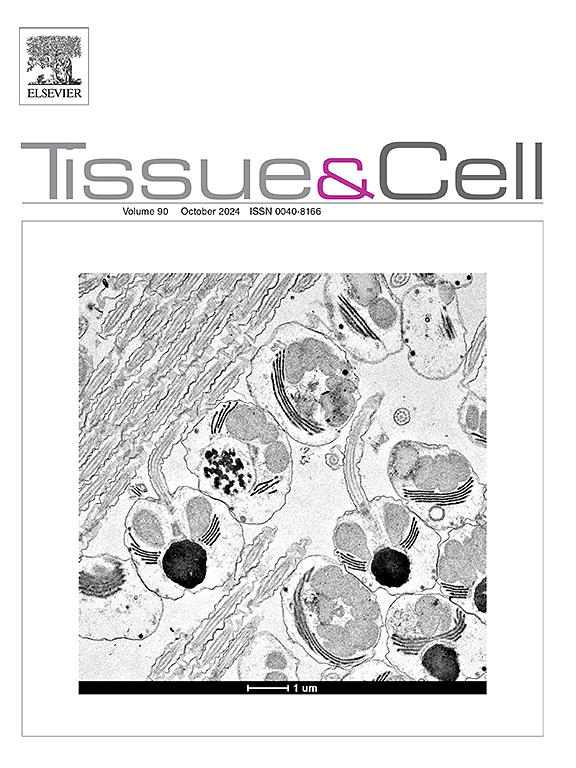Clinical evaluation and characterization of normal perioral tissues with a new advanced videodermatoscopy method: A cross-sectional pilot study on dental students
IF 2.7
4区 生物学
Q1 ANATOMY & MORPHOLOGY
引用次数: 0
Abstract
Aims
The main outcome is to describe the key dermatomucosal structures of the healthy perioral tissues and to assess their visibility and ease of identification, using an innovative advanced dermatoscopic technique.
Methods
this pilot observational cross-sectional clinical study was conducted to evaluate and describe the characteristics of healthy perioral tissue in 40 young-adult subjects. For all subjects, two lightweight probes were used, with different magnifications. For each patient, three anatomical areas of interest were identified: the anterior chin area (ACA); the transition zone between the ACA and the labial integument, also known as the vermilion border (VB), and the pigmented area of the lip, also known as the vermilion zone (VZ). These were evaluated with both white light and polarized light. The acquired dermatoscopic and fluorescence-advanced videodermatoscopy (FAV) images were carefully reviewed by two independent investigators. In addition to a descriptive phase focusing on the normal anatomy of various regions, a qualitative assessment of the visibility of the mucocutaneous structures was performed. Image analysis utilized the visibility scale.
Results
Visibility scores significantly differed between lighting modes and magnification levels. Skin texture was better visualized with non-polarized light (p < 0.001), while polarized light improved visualization of pores and vascular structures (p < 0.01). No significant differences emerged by gender, skin type, or phototype.
Conclusion
these findings highlight the capability of FAV technology to provide detailed visualization of both epithelial and non-epithelial structures, with consistent patterns of visibility across different anatomical zones.
一种新的先进视频皮肤镜检查方法对正常口腔周围组织的临床评价和特征:一项牙科学生的横断面试点研究
目的:主要结果是描述健康口腔周围组织的关键皮肤粘膜结构,并评估其可见性和识别的便利性,使用创新的先进皮肤镜技术。方法本研究是一项前瞻性的观察性横断面临床研究,旨在评估和描述40名年轻成人健康口腔周围组织的特征。所有受试者都使用了两种不同倍率的轻型探针。对于每个患者,确定了三个感兴趣的解剖区域:前下巴区域(ACA);ACA和唇被膜之间的过渡区,也称为朱红色边界(VB),以及嘴唇的色素区,也称为朱红色区(VZ)。用白光和偏振光对其进行了评价。获得的皮肤镜和荧光高级视频皮肤镜(FAV)图像由两名独立调查员仔细审查。除了描述阶段侧重于各个区域的正常解剖外,还对皮肤粘膜结构的可见性进行了定性评估。图像分析采用能见度尺度。结果不同照明方式和放大倍数对可视性评分有显著影响。非偏振光能更好地显示皮肤纹理(p <;0.001),而偏振光改善了孔隙和血管结构的可视化(p <;0.01)。性别、皮肤类型或光型之间没有显著差异。结论:这些发现强调了FAV技术能够提供上皮和非上皮结构的详细可视化,并且在不同解剖区域具有一致的可见模式。
本文章由计算机程序翻译,如有差异,请以英文原文为准。
求助全文
约1分钟内获得全文
求助全文
来源期刊

Tissue & cell
医学-解剖学与形态学
CiteScore
3.90
自引率
0.00%
发文量
234
期刊介绍:
Tissue and Cell is devoted to original research on the organization of cells, subcellular and extracellular components at all levels, including the grouping and interrelations of cells in tissues and organs. The journal encourages submission of ultrastructural studies that provide novel insights into structure, function and physiology of cells and tissues, in health and disease. Bioengineering and stem cells studies focused on the description of morphological and/or histological data are also welcomed.
Studies investigating the effect of compounds and/or substances on structure of cells and tissues are generally outside the scope of this journal. For consideration, studies should contain a clear rationale on the use of (a) given substance(s), have a compelling morphological and structural focus and present novel incremental findings from previous literature.
 求助内容:
求助内容: 应助结果提醒方式:
应助结果提醒方式:


